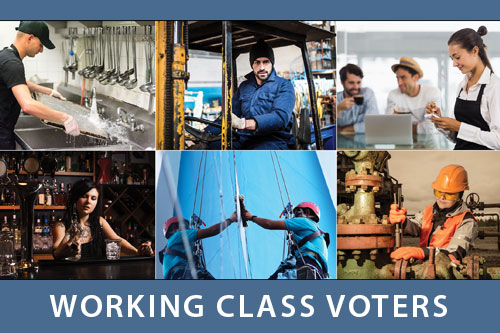Some Nuggets from E. J. Dionne, Jr.’s latest Washington Post column: “Whereas Trump’s apostasy on abortion was out in the open, it was barely noticed that the GOP platform also dropped its opposition to same-sex marriage — because roughly 7 in 10 Americans now support it. The right turned to highlighting transgender issues precisely because there is now broad support for so much of the rest of the LGBTQ+ rights agenda….Yes, the GOP succeeded in using the transgender issue to paint Harris as the “they/them” candidate. But on so many questions, the broad liberalizing trends of the past three decades are alive and well, and understanding how far progressive positions have advanced is central to recognizing that Trump’s narrow victory did not represent a sharp movement to the right akin to Ronald Reagan’s 1980 triumph. Trump’s combined margin in the decisive swing states of Pennsylvania, Michigan and Wisconsin was, as of Friday’s tallies, just around 231,000. That number does not justify apocalyptic electoral analysis….Of course, reproductive rights activists don’t feel like winners. Even after Missouri’s vote, 12 states, including populous Texas, still have broad abortion bans, and four more, including Florida, have bans after roughly six weeks of pregnancy. In conservative states, Republicans will continue to push restrictions, including new barriers to medication abortions…./Being mindful of the largely hidden liberal victories of 2024 does not mean downplaying the challenges Democrats face — or the dangers Trump’s genuinely radical agenda presents. But to acknowledge the gains is to see that the country Trump will lead is neither as supportive of his agenda as he claims nor as allergic to progressive change as many of his adversaries fear. One defeat, however stunning, does not discredit the value of persuasion and coalition-building. They take time. They still work.”
Caroline Vakil and Julia Mueller spotlight “5 pivotal 2025 contests that could also be Trump litmus tests” at The Hill, and write: “New Jersey Reps. Mikie Sherrill and Josh Gottheimer, former state Senate President Steve Sweeney, Jersey City Mayor Steven Fulop, former Montclair Mayor Sean Spiller and Newark Mayor Ras Baraka are among the Democrats who have jumped into the race….In Virginia, where Trump also improved upon his 2020 showing this year, Republican Gov. Glenn Youngkin is limited to a single term…On the Democratic side, Rep. Abigail Spanberger (D-Va.) launched her campaign late last year. Though there’s still time for other candidates to crowd into the race, a Spanberger match-up against Earle-Sears would be historic, potentially paving way for Virginia’s first female governor.” In the New York City Mayor’s race, “The declared Democratic candidates include New York City Comptroller Brad Lander, New York State Assembly member Zohran Mamdani, state Sens. Zellnor Myrie and Jessica Ramos, former New York City Comptroller Scott Stringer, former Obama White House aide Michael Blake and Democratic donor Whitney Tilson….New Yorkers are watching to see whether state Attorney General Letitia James (D) or former Gov. Andrew Cuomo (D) will also enter the ring…..Democrats flipped control of the Virginia House of Delegates two years ago, giving them a narrow 51-49 majority. But Trump’s performance across the state and elsewhere during the 2024 election is raising questions about whether that favorable political environment for Republicans will carry into the next elections….Biden carried the state by 10 points in 2020, with Harris only carrying it by 5 points earlier this month….Partisan control is on the line in the upcoming Wisconsin Supreme Court election….The state’s high court currently has a 4-3 liberal tilt, but Justice Ann Walsh Bradley’s retirement will bring it to an even 3-3 split….The last Wisconsin Supreme Court election in 2023, which also determined partisan control on the high court, shattered records in spending as groups threw tens of millions of dollars into advertising. Experts say they won’t be surprised if the same is true again this cycle.”
In “Trump voters feel very differently about things now that he’s won, our new poll shows,” Jessica Piper writes at Politico: “Donald Trump’s supporters thought voter fraud could determine the election outcome — until he won. Heading into Election Day, nearly 9 in 10 Trump voters said fraud was a serious issue. Afterward, just a bit over one-third said so….his supporters were also more likely to feel good about the economy after the election — while Harris supporters adopted a more negative outlook….Those are among the results of a new POLITICO|Morning Consult poll, designed to measure change in public opinion before and after the election. The results largely track with recent consumer sentiment data and comments from Republican leaders …The first poll (toplines, crosstabs) was conducted from Oct. 30 to Nov. 1, the week before the election, while the second (toplines, crosstabs) was in the field from Nov. 20 through 22, two weeks after Trump’s victory. Both surveys sampled more than 4,000 registered voters, with a margin of error of 2 percentage points….In polling just days before the election, Trump supporters expressed little confidence in the election outcome, with a whopping 87 percent substantially or somewhat agreeing with the statement that voter fraud was a “serious issue” that could determine the outcome of the election. Among Harris supporters, roughly half expressed similar worries….That partisan divide disappeared after Election Day….A week before the election, just 8 percent of self-identified Trump voters described the economy as on the “right track,” the polling found. But after Trump’s victory, that number swung to 28 percent — still a minority, but a substantial swing in a span of just a few weeks when economic conditions did not change dramatically….Trump supporters were also far more optimistic than Harris supporters across a range of policy areas, with some of the greatest divides coming on national security (75 percent of Trump voters were optimistic compared with 30 percent of Harris voters) and public health (73 percent of Trump voters optimistic compared with 33 percent of Harris voters).”
Robert J. Shapiro argues that “Kamala Harris’s Policy Agenda Kneecapped Her Chances” at the Washington Monthly. As Shapiro notes, “Ultimately, her heaviest burden was being nominated without a normal primary process that would have allowed her to hone a winning agenda. In a closely fought election, it’s incumbent on the lesser-known candidate to offer a compelling policy agenda, especially for weak partisans and independents….But the Harris campaign never came to grips with the three issues that voters cared about most—the continuing pain of inflation, the disappointment of voters without college degrees about their narrowing prospects, and the anxieties Americans feel about immigrants crossing the border without a legal right to do so. According to polls and surveys, substantial majorities expected and demanded that the candidates address those three concerns meaningfully….That’s how democracy works. Yet, the strategists who Harris inherited from Joe Biden’s campaign—which was faltering even before his unfortunate debate performance—tried to convince voters to focus on abortion rights and threats to democracy. They didn’t appreciate how downplaying the voters’ most pressing concerns could align Harris with the status quo. Worse, Harris’s team didn’t fully appreciate how the context for the issues they considered more important had changed….By making abortion access the touchstone of her closing argument, Harris also may have sent a message to persuadable voters that their frustrations about the economy and immigration were secondary….More importantly, in the end, the Harris campaign didn’t make a persuasive case that she had the ideas and strength to address voters’ real concerns, given her difficulty separating herself from an administration that voters believed hadn’t done enough about those concerns….The Harris campaign completed their self-damaging trifecta by missing the mark on immigration. Their approach was to trumpet the administration’s support for immigration reform on “day one” and the bipartisan compromise on immigration earlier this year. But since neither passed Congress, she ended up boasting about the administration failing to make a difference for the voters’ third hot-button concern….In a populist era, voters demand that a candidate offer concrete actions that could plausibly change the conditions and circumstances that frustrate and anger them and then display the personal strength to carry them out. Kamala Harris has that strength, but it wasn’t enough because her campaign never provided a convincing blueprint.”















